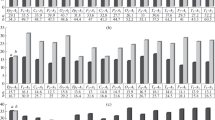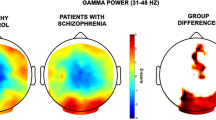Abstract
We report here a comparative analysis of measures of spectral power and synchronization of the gamma rhythm (30–40 Hz) in healthy subjects in normal conditions and before examinations (a stress situation) and in patients with major depression (first episode), both without cognitive loading and during performance of tests (arithmetic counting and spatial imagination). The results showed that the power of the gamma rhythm in the frontal and temporal areas of the cortex was significantly greater in patients with depression than in normal subjects. In the stress situation, healthy subjects showed a reduction in the number of differences in this measure as compared with depression patients, both at rest and during performance of the arithmetic counting test. the spatial imagination test resulted in a smaller number of significant differences between patients with depression and healthy subjects, regardless of whether the latter were in normal conditions or in the stress situation. The levels of gamma rhythm synchronization between cortical areas at rest and during cognitive loading were not different in healthy subjects, though synchronization increased in healthy subjects during stress and in patients with depression. Thus, the stress situation in healthy subjects leads to decreases in the differences in EEG measures from those in depression both at rest (power) and during cognitive loading (both measures). This may be evidence that stress is a “trigger mechanism” for depression.
Similar content being viewed by others
References
A. S. Avedisova and A. F. Faizulloev, “Cognitive functions and methods for studying them,” Ros. Psikhiatr. Zh., No. 1, 16–20 (2003).
N. N. Danilova and N. B. Bykova, “Oscillatory activity of the brain and information processes,” in: Proceedings of the Scientific Conference in Memory of Corresponding Member of the Russian Academy of Sciences A. V. Brushlinskii. Psychology: Current Directions in Interdisciplinary Studies [in Russian], Moscow (2003), pp. 271–283.
N. N. Danilova and N. B. Bykova, “The role of frequency-specific codes in attention processes,” in: A. R. Luriya and Psychology in the 21st Century. Proceedings of the Second International Conference Celebrating the 100th Anniversary of the Birth of A. R. Luriya [in Russian], Moscow (2003), pp. 290–295.
V. V. Lazarev, “EEG assessment of the neurodynamic structure of mental activity in asthenodepressive states,” in: Proceedings of the Sixth International Interdisciplinary Conference on the Biology of Psychiatry “Stress and Behavior,” Moscow (2001), p. 27.
M. N. Livanov, Spatial Organization of Brain Processes [in Russian], Nauka, Moscow (1972).
E. S. Mikhailova, M. Ya. Tsutsul’kovskaya, and I. V. Oleichik, “Neurophysiological mechanisms of impairments of the recognition of emotions in endogenous depression,” Zh. Nevropatol. Psikhiatr. S. S. Korsakova, 100, No. 1, 38–43 (2000).
A. B. Smulevich, Depression in Somatic and Mental Disorders [in Russian], Med. Inf. Agentstvo, Moscow (2003).
V. B. Strelets, N. N. Danilova, and I. V. Kornilova, “EEG rhythms and psychological indicators of emotions in reactive depression,” Zh. Vyssh. Nerv. Deyat., 47, No. 1, 11–21 (1997).
V. B. Strelets, A. M. Ivanitskii, and O. K. Artseulova, “Dynamics of neurophysiological measures in reactive (situational) depression,” Fiziol. Cheloveka, 20, No. 6, 64–74 (1994).
V. B. Strelets, A. M. Ivanitskii, G. A. Ivanitskii, O. K. Artseulova, V.Yu. Novototskii-Vlasov, and Zh. V. Golikova, “Impairments in the organization of cortical process in depression,” Zh. Vyssh. Nerv. Deyat., 46, No. 4, 274–281 (1996).
V. B. Strelets, N. N. Samko, and Zh. V. Golikova, “Physiological indicators of pre-examination stress,” Zh. Vyssh. Nerv. Deyat., 48, No. 3, 458–462 (1998).
E. Basar, C. Basar-Eroglu, S. Karakas, and M. Schuerman, “Brain oscillations in perception and memory,” Int. J. Psychophysiol., 35, 95–124 (2000).
R. P. Behrendt, “Hallucinations: Synchronisation of thalamo-cortical gamma-oscillations underconstrained by sensory input,” Conscious. Cogn., 12, 413–451 (2003).
M. R. Bennet, The Idea of Consciousness. Synapses and the Mind, Harwood Academic Publishers, UK, (1997).
R. J. Davidson, “Anterior electrophysiological asymmetries, emotion, and depression: conceptual and methodological conundrums,” Psychophysiology, 35, No. 5, 607–614 (1998).
M. C. Gemar, S. Kapur, Z. V. Segal, G. M. Brown, and S. Houle, “Effects of self-generated sad mood on regional cerebral activity: a PET study in normal subjects,” Depression, 4, 81–88 (1996).
R. C. Gur, R. J. Erwin, R. E. Gur, A. S. Zwil, C. Heimberg, and H. C. Kraemer, “Facial Emotions Discrimination: II. Behavioral findings in depression,” Psych. Res., 42, 241–251 (1992).
W. Heller, M. A. Etienne, and G. A. Miller, “Patterns of perceptual asymmetry in depression and anxiety: implications for neuropsychological models of emotion and psychopathology,” J. Abnorm. Psychol., 104, No. 2, 327–333 (1995).
C. E. Izard, “The structure and functions of emotions: implications of cognition, motivation and personality,” in: the Stanley Hall Lectures Series, I. S. Cohen (ed.), American Psychology Association, Washington (1989), Vol. 9, pp. 35–73.
V. Knott, C. Mahoney, S. Kennedy, and K. Evans, “EEG power, frequency, asymmetry and coherence in male depression,” Psych. Res.: Neuroimaging, 106, No. 2, 123–140 (2001).
R. S. Lazarus, “On the primacy of cognition,” Amer. Psychol, 39, No. 2, 124–129 (1984).
K.-H. Lee, “Synchronous gamma-activity; a review and contribution to an integrative neuroscience model of schizophrenia,” Brain Res. Rev., 41, 57–78 (2003).
R. R. Llinas and U. Ribary, “Coherent 40-Hz oscillation characterizes dream state in humans,” Proc. Natl. Acad. Sci. USA, 90, 2078–2081 (1993).
F. Lopa da Silva, “The rhythms of the brain: mirrors of the working of brain systems that underlie cognitive functions,” in: Behind and Beyond the Brain, Fundacao Bial, Porto (2000), pp. 23–55.
S. G. Siris, “Depression in the course of schizophrenia,” in: Schizophrenia and Comorbid Conditions. Diagnosis and Treatment, American Psychiatric Press,Washington, London (2001), pp. 31–56.
V. B. Strelets, V. Y. Novototsky-Vlasov, and J. V. Golikova, “Cortical connectivity in high frequency beta-rhythm in schizophrenics with positive and negative symptoms,” Int. J. Psychophysiol., No. 44, 101–115 (2002).
D. Tucker, A. Hartry-Speiser, L. McDougal, P. Luu, and D. Grandpre, “Mood and spatial memory: emotion and right hemisphere contribution to spatial cognition,” Biol. Psychol., 50, No. 2, 103–125 (1999).
R. B. Zajonc, “On the primacy of affect,” Amer. Psychol., 39, No. 2, 117–123 (1984).
Author information
Authors and Affiliations
Additional information
__________
Translated from Zhurnal Vysshei Nervnoi Deyatel’nosti imeni I. P. Pavlova, Vol. 56, No. 2, pp. 219–227, March–April, 2006.
Rights and permissions
About this article
Cite this article
Strelets, V.B., Garakh, Z.V. & Novototskii-Vlasov, V.Y. Comparative study of the gamma rhythm in normal conditions, during examination stress, and in patients with first depressive episode. Neurosci Behav Physiol 37, 387–394 (2007). https://doi.org/10.1007/s11055-007-0025-4
Received:
Accepted:
Issue Date:
DOI: https://doi.org/10.1007/s11055-007-0025-4




